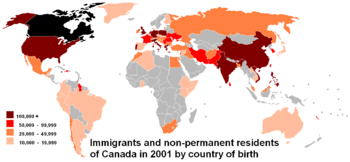 |
| Country of birth of "immigrants and non-permanent residents" in Canada in 2001 Census (Photo credit: Wikipedia) |
The Government of Canada recognizes the importance of immigration in fueling economic growth and is planning to welcome between 260,000 and 285,000 new permanent residents in 2015, an increase of approximately 19,000 planned admissions over last year.
The economic category will account for the largest segment of the 2015 levels plan, at almost 65 per cent of overall admissions. The remaining 35 per cent will consist of family class immigrants, refugees and others admitted under humanitarian programs.
Higher levels in 2015 are an indication of the Government of Canada’s strategy of supporting economic growth by addressing current and future labour needs by increasing admissions in key economic programs. Canada’s future economic growth will require a steady stream of new immigrants to meet labour market demands.
The increase in levels will also assist Citizenship and Immigration Canada’s implementation of the new application management system, Express Entry, in January 2015 and positions our immigration system to focus more on economic immigration in the future. This first year of Express Entry will be a transition year for economic immigration: while new applications under the Federal Skilled Worker Program (FSWP), Federal Skilled Trades Program, Canadian Experience Class (CEC) and a portion of the Provincial Nominee Program (PNP) will be managed in Express Entry, most admissions in 2015 will be of applicants who applied under the previous system. Increasing admission levels creates the conditions for the success of the new system in 2015 by providing enough space to accommodate pre-Express Entry cases while providing flexibility to admit higher volumes under Express Entry as soon as possible.
Highlights:
- The FSWP admissions will rise slightly in 2015 to up to 51,000. This program will continue to accept the most permanent resident admissions for 2015.
- The CEC has grown rapidly since launching in late 2008, with more admissions expected this year than ever before. To accommodate the rapid growth of this popular program, Citizenship and Immigration Canada will accept up to 23,000 permanent residents through the CEC in 2015.
- Canada plans to welcome up to 48,000 permanent residents under the PNP in 2015. This represents the highest-ever provincial nominee admissions in history.
- An increase in admissions to the caregiver programs will take place in 2015. The increase of up to 30,000 caregivers will help to accelerate reduction of the existing Live-in Caregiver Program backlog.
Text version
Graph showing rapid growth of the CEC program from 2009 to 2013, broken down by principal applicants and spouses/dependants.
| Year | CEC principal applicants | CEC spouses and dependants |
|---|
| 2009 | 1,775 | 770 |
| 2010 | 2,533 | 1,384 |
| 2011 | 3,973 | 2,054 |
| 2012 | 5,943 | 3,416 |
| 2013 | 15,304 | 11,460 |
The Canadian Experience Class (CEC) is targeting the type of economic immigrant Canada wants: people who have demonstrated success in the Canadian labour market and who have the skills to contribute to our country over the long run. The CEC has grown rapidly since launching in late 2008, with more admissions expected this year than ever before. To accommodate the rapid growth of this popular program, Citizenship and Immigration Canada will accept up to 23,000 permanent residents through the CEC in 2015.
Text version
Two maps, one from the year 2000 and the other from 2013, showing the growth and dispersion of economic immigrants thanks to the Provincial Nominee Program. The 2013 map shows greater dispersion of PNP immigrants throughout the country, particularly in the Prairies and Maritime provinces.
Provincial Nominee Program
The Provincial Nominee Program is Canada’s second-largest economic immigration program and has helped to diversify and spread the benefits of immigration across the country. Canada plans to welcome between 46,000 and 48,000 permanent residents under the PNP in 2015. This represents the highest-ever provincial nominee admissions in history.
Source: CIC






















